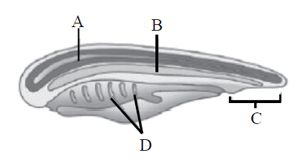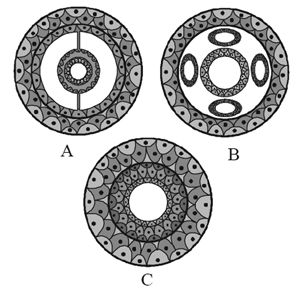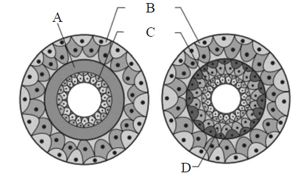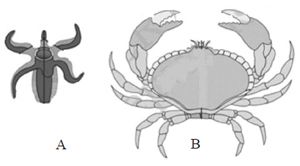Match the characteristic feature/terms given in column I with the phylum to which they belongs given in column II and choose the correct option.
| Column-I | Column-II |
|---|---|
| (Characteristic feature/term) | (Phylum) |
| A. Choanocytes | I. Platyhelminthes |
| B. Cnidoblasts | II. Ctenophora |
| C. Flame cells | III. Porifera |
| D. Nephridia | IV. Coelenterata |
| E. Comb plates | V. Annelida |
A II; B I; C IV; D V; E III
A II; B IV; C I; D V; E III
A V; B I; C III; D II; E IV
A III; B IV; C I; D V; E II
Correct Answer :
D. A III; B IV; C I; D V; E II
Related Questions
Which of the following characteristic is probably most responsible for the great diversification of insects on land ?
Segmentation
Antennae
Bilateral symmetry
Exoskeleton
Which of the following statement(s) is/are correct regarding phylum aschelminthes?
(i) The body is circular in cross-section hence the name roundworms.
(ii) Alimentary canal is complete with a well-developed muscular pharynx.
(iii) Sexes are separate (dioecious), i.e., males and females are distinct.
(iv) Nephridia help in osmoregulation and excretion.
(i) and (ii)
(iii) and (iv)
(i), (ii) and (iii)
All of these
The given figure shows some characteristic features marked as chordates. Identify the correct labelling A,B,C and D.

A-Notochord; B-Post-anal part; C-Gill slits; D-Nerve cord
A-Nerve cord; B-Notochord; C-Post-anal part; D-Gill slits
A-Notochord; B-Nerve cord; C-Gill slits; D-Post-anal part
A-Gill slits; B-Post-anal part; C-Nerve cord; D-Notochord
Which of the following traits is not shared by both sea anemones and jellyfish ?
A medusa as the dominant stage in the life cycle.
Possession of a gastro vascular cavity.
Sexual reproduction.
Nematocysts present on the tentacles.
Which of the following is a poisonous snake?
Naja (Cobra)
Bangarus (Krait)
Viper (Viper)
All of these
Which of the following is not a characteristic feature of kingdom animalia ?
Storage of carbohydrates as starch.
Multicellularity.
Obtaining nutrients by ingestion.
Having eukaryotic cells without walls.
Few cnidarians like corals have a skeleton composed of
calcium hydroxide
calcium sulphate
calcium carbonate
sodium bicarbonate
__________ is responsible for maintaining the current of water in sponge.
Osculum
Porocytes
Spongocoel
Choanocytes
The following statement are associated with the occurrence of notochord. Identify the incorrect statement.
It is present only in larval tail in ascidians.
It is replaced by a vertebral column in adult frog.
It is absent throughout the life in humans from the very beginning.
It is present throughout life in Amphioxus.
Which of the following group of animals reproduces only by sexual means?
Ctenophora
Cnidaria
Porifera
Protozoa
Which one of the following statement regarding coelom of given animals is correct?
Round worms (aschelminthes) are pseudocoelomates.
Molluscs are acoelomates.
Insects are pseudocoelomates.
Flatworms (platyhelminthes) are coelomates.
In phylum echinodermata, the adult echinoderms are ______A__________ but larvae are _______B______ .
A radially symmetrical; B bilaterally symmetrical
A bilaterally symmetrical; B radially symmetrical
A bilaterally symmetrical; B asymmetrical
A metamerically segmented; B asymmetrical
Refer the types of cells present in some animals. Each cell is specialized to perform a single specific function except
Cnidocytes
Choanocytes
Interstitial cells
Gastrodermal cells
Which of the following pairs of animals are similar to each other pertaining to the feature stated against them?
Pteropus and Ornithorhyncus - Viviparity
Garden lizard and crocodile - Three chambered heart
Ascaris and Ancylostoma - Metameric segmentation
Sea horse and flying fish - Cold blooded (poikilothermal)
Examine the figures A, B and C. In which one of the four options all the items A, B and C are correctly identified ?

A - Sycon, B - Euspongia, C - Spongilla
A - Euspongia, B - Spongilla, C - Sycon
A - Spongilla, B - Sycon, C - Euspongia
A - Euspongia, B - Sycon, C - Spongilla
Animals like annelids, arthropods, etc. where the body can be divided into identical left and right halves in only one plane, exhibit___________symmetry.
radial
bilateral
asymmetrical
non- symmetrical
Identify the correct characteristic feature shown by the given figure?

Diploblastic in nature.
Having radial symmetrical body.
Dioecious with direct development.
Presence of sensory tentacles on anterior head region.
In amphibians, respiration occurs through
gills
lungs
skin
all of these
Which of the following class is being correctly described by given statements (i - iv)?
(i) All living members of this class are ectoparasites on some fishes.
(ii) They have a sucking and circular mouth without jaws.
(iii) Circulation is of closed type.
(iv) They are marine but migrate for spawning to fresh water. After spawing, within a few days they die.
Cyclostomata
Chondrichthyes
Osteichthyes
Amphibia
Identify the figures and select the correct option

A - Pseudocoelomate; B - Coelomate, C-Acoelomate
A - Coelomate, B - Pseudocoelomate, C- Acoelomate
A - Coelomate; B- Acoelomate; C - Pseudocoelomate
A - Coelomate; B- Acoelomate; C-Eucoelomate
Match the phylum given in column - I with their example given in column - II and choose the correct option.
| Column -I | Column- II |
|---|---|
| (Phylum) | (Examples) |
| A. Echinodermata | I. Ascidia, Doliolum |
| B. Hemichordata | II. Asterias, Ophiura |
| C. Urochordata | III. Branchiostoma |
| D. Cephalochordata | IV. Balanoglossus, Saccoglossus |
A IV; B II; C I; D III
A II; B IV; C I; D III
A II; B IV; C III; D I
A II; B I; C IV; D III
Match the phylum given in column - I with the special features present in them given in column - II and choose the correct option.
| Column -I | Column- II |
|---|---|
| (Phylum) | (Special features present) |
| A. Porifera | I. Mammary glands |
| B. Mollusca | II. Cloaca |
| C. Ctenophora | III. Choanocytes |
| D. Amphibia | IV. Radula |
| E. Mammalia | V. Comb plates |
A III; B IV; C V; D II; E I
A IV; B III; C V; D II; E I
A III; B IV; C II; D V; E I
A III; B V; C IV; D II; E I
Which of the following statements (i - v) are correct ?
(i) The pelvic fins of female sharks bear claspers.
(ii) In Obelia, polyps produce medusae sexually and medusae form the polyps asexually.
(iii) Flame cells in platyhelminthes help in osmoregulation and excretion.
(iv) In non-chordates, central nervous system is ventral, solid and double.
(v) Pinnae are present in mammals.
(ii), (iv) and (v)
(i), (iii) and (v)
(iii), (iv) and (v)
(i), (ii) and (iii)
The figure given below shows the germinal layers marked as A, B, C and D. Identify the label showing undifferentiated layer and its location?

A, Between B & C
B, Between A & C
C, Between C & D
D, Between A & B
Which of the following feature in birds indicates their reptilian ancestory ?
Eggs with a calcareous shell
Scales on their hind limbs
Four-chambered heart
Two special chambers-crop and gizzard in their digestive tract
Flame cells present in platyhelminthes, are specialized in
respiration and absorption.
osmoregulation and circulation.
respiration and excretion.
osmoregulation and excretion.
Match the characteristic feature/terms given in column I with the phylum to which they belongs given in column II and choose the correct option.
| Column-I | Column-II |
|---|---|
| (Characteristic feature/term) | (Phylum) |
| A. Choanocytes | I. Platyhelminthes |
| B. Cnidoblasts | II. Ctenophora |
| C. Flame cells | III. Porifera |
| D. Nephridia | IV. Coelenterata |
| E. Comb plates | V. Annelida |
A II; B I; C IV; D V; E III
A II; B IV; C I; D V; E III
A V; B I; C III; D II; E IV
A III; B IV; C I; D V; E II
Match the organisms given in column-I with their common name given in column-II and choose the correct option.
| Column -I | Column -II |
|---|---|
| (Organisms) | (Comman name) |
| A. Pennatula | I. Sea-lily |
| B. Antedon | II. Sea- pen |
| C. Echinus | III. Sea-urchin |
| D. Cucumaria | IV. Sea - cucumber |
A II; C III; D I; E IV
A II; C IV; D I; E III
A II; C I; D III; E IV
A II; C I; D III; E IV
A student was given a specimen to identify on the basis of the characteristics given below.
(i) They are metamerically segmented.
(ii) Presence of closed circulatory system.
(iii) They have circular and longitudinal muscles for locomotion. Identify the specimen.
Prawn
Pheretima
Wuchereria
Ctenoplana
The given figures of animals (A & B) are distinguished on the basis of symmetry. Select the correct option which shows the type of symmetry and its description against the animals.

A : Biradial, organisms is divided into unequal halves by any plane through the central axis.
B: Bilateral, body is divided into equivalent right and left halves by only one plane.
A: Asymmetrical, organisms is not divided into equal halves by any plane through the central axis.
B: Radial, in which any plane passing through the central axis of the body divides the organism into two identical halves.
